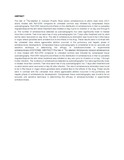| dc.contributor.author | Waruiru, RM | |
| dc.date.accessioned | 2014-04-30T09:15:01Z | |
| dc.date.available | 2014-04-30T09:15:01Z | |
| dc.date.issued | 1991 | |
| dc.identifier.citation | Bulletin of Animal Health and Production in Africa 1991 Vol. 39 No. 3 pp | en_US |
| dc.identifier.uri | http://www.cabdirect.org/abstracts/19920879698.html?resultNumber=9&q=au%3A%22Waruiru%2C+R.+M.%22 | |
| dc.identifier.uri | http://hdl.handle.net/11295/66204 | |
| dc.description.abstract | The fate of 75Se-labelled S. mansoni (Puerto Rican strain) schistosomula in albino male mice (CD-1 strain) treated with Roll-0761 compared to untreated controls was followed by compressed tissue autoradiography. Roll-0761 had profound effects on the distribution of schistosomula in that no parasites migrated beyond the skin when treatment was initiated on day 0 prior to infection or on day one through 6 pi. The number of schistosomula detected as autoradiographic foci were significantly lower in treated mice than controls. Test mice were free of any autoradiographic foci 7 days after treatment and no adult worms were recovered on day 42 pi. The site of schistosomula elimination was found to be in the tissue or organ where parasites were arrested due to the effects of the drug. These results were in contrast with the untreated mice where appreciable attrition occurred in the pulmonary and hepatic phase of schistosomular development. Compressed tissue autoradiography is considered to be an accurate and sensitive technique in determining the efficacy of schistosomulicides in experimental schistosomiasis.ADDITIONAL ABSTRACT:The fate of 75Se-labelled Schistosoma mansoni schistosomula in mice treated with Roll-0761 compared to untreated controls was followed by compressed tissue autoradiography. Roll-0761 had profound effects on the distribution of schistosomula in that no parasites migrated beyond the skin when treatment was initiated on day zero prior to infection or on day 1 through 6 after infection. The numbers of schistosomula detected as autoradiographic foci were significantly lower in treated mice than controls. Test mice were free of any autoradiographic foci 7 days after treatment and no adult worms were recovered on day 42 after infection. The site of schistosomula elimination was found to be in the tissue or organ where parasites were arrested due to the effects of the drug. These results were in contrast with the untreated mice where appreciable attrition occurred in the pulmonary and hepatic phase of schistosomular development. Compressed tissue autoradiography was found to be an accurate and sensitive technique in determining the efficacy of schistosomulicides in experimental schistosomiasis. | en_US |
| dc.language.iso | en | en_US |
| dc.publisher | University of Nairobi, | en_US |
| dc.title | Autoradiographic analysis of the effects of Roll-0761 on the attrition and distribution patterns of 75Se-labelled Schistosoma mansoni schistosomula in mice. | en_US |
| dc.type | Article | en_US |

